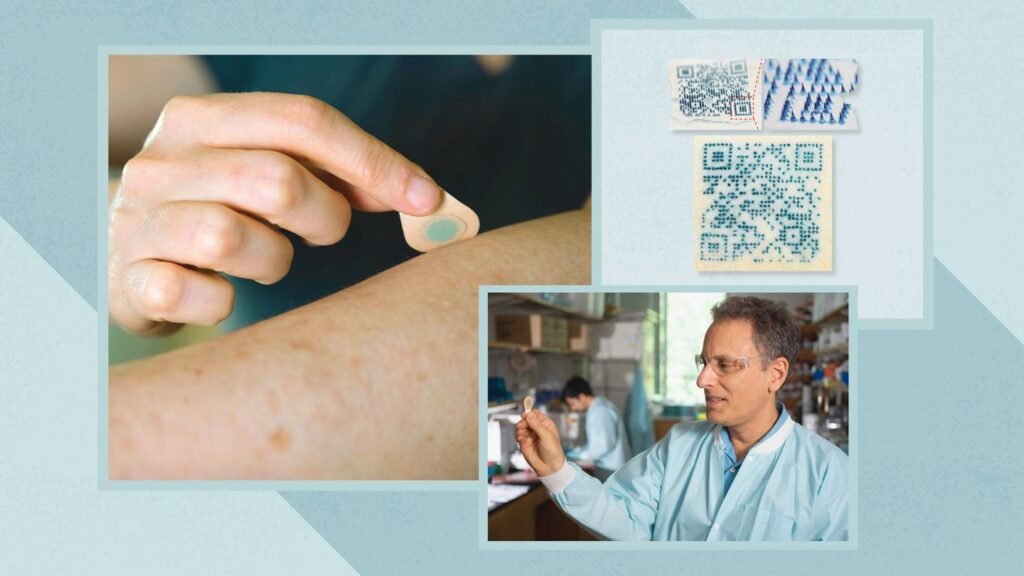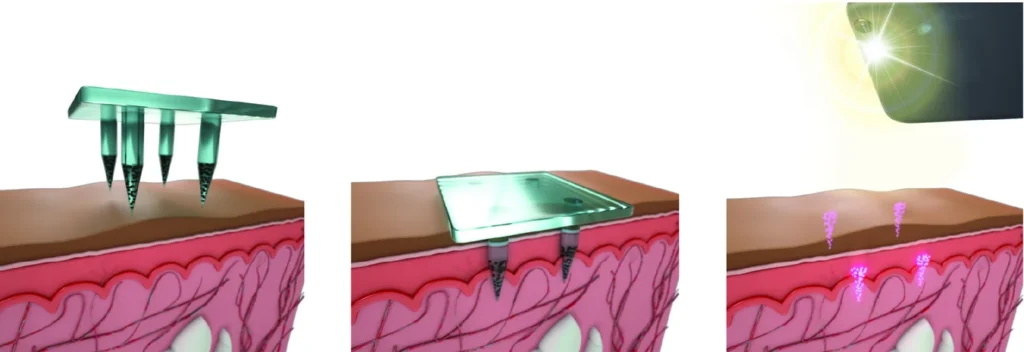Imagine a world where the traditional paper vaccination records are a thing of the past. Instead, a small and discreet tattoo is placed on a child’s skin, containing vital information about their vaccination history. This technology is not a work of fiction but a reality that could soon be implemented in healthcare settings worldwide.
NIH: The first human clinical trial for flu vaccination using microneedle patches

The first-in-human clinical trial of the flu vaccine patches began in June 2015 with 100 participants aged 18-49 who were healthy and who had not received the influenza vaccine during the 2014-15 flu season. The study was conducted at the Hope Clinic of the Emory Vaccine Center in Atlanta. The study was carried out under an Investigational New Drug Application authorized by the FDA.
Participants were randomized into four groups: (1) vaccination with microneedle patch given by a health care provider; (2) vaccination with microneedle patch self-administered by study participants; (3) vaccination with intramuscular injection given by a health care provider; and (4) placebo microneedle patch given by a health care provider.

Bill Gates and His Failed Vaccines:
Bill Gates visited the Vaccine Research Center at the National Institutes of Health (NIH), where he got to see firsthand how researchers are utilizing VR technology to analyze viruses and identify potential targets for vaccines or medications.
Invisible Ink: The Sneaky Way Tattoos Could Track Your Child’s Vaccination Status
A new method has been developed to store vaccination records under a child’s skin using invisible ink. This could help in easily identifying whether kids have been vaccinated.
A group of Massachusetts Institute of Technology researchers has developed a new method to address the challenge of keeping track of vaccinations, by embedding the record directly into the skin of a child along with a bit of invisible dye that can be easily seen with a special cell-phone filter and app.
The dye, expected to last up to five years, has been tested on pig, rat, and human skin in a dish, providing quick and easy access to vaccination history, reducing the risk of clerical errors, and adding minimal cost or risk to the procedure.
The system, not yet tested in children, aims to provide valuable medical information directly associated with a person, especially in developing countries where medical records may be incomplete or inaccessible, according to bioengineering professor Mark Prausnitz from the Georgia Institute of Technology.
The research, conducted by M.I.T. bioengineers Robert Langer and Ana Jaklenec and their colleagues, uses a patch of tiny needles called microneedles to provide an effective vaccination without a teeth-clenching jab. Microneedles are embedded in a Band-Aid-like device that is placed on the skin; a skilled nurse or technician is not required. Vaccines delivered with microneedles also may not need to be refrigerated, reducing both the cost and difficulty of delivery, Langer and Jaklenec say.
The research uses microneedles to provide effective vaccination without a traditional injection
The dye used is a technology called quantum dots.

With concerns about the authenticity of paper records and the potential for them to be lost or damaged, invisible ink tattoos offer a more secure and permanent solution. These tattoos are only visible under specific lighting conditions
A microneedle patch that records vaccination history on skin

Prausnitz, a key figure in microneedle technology, highlights privacy concerns related to the approach of storing medical records through invisible medical tattoos.
Patients may have reservations about having personal medical information tattooed on their bodies, as well as concerns about the unfamiliarity of this method.
Jaklenec and her team sought to create an identifier that would be invisible to the naked eye, avoiding the visible scarring caused by traditional vaccination methods and steering clear of technologies that could potentially compromise privacy, such as iris scans and databases with identifiable data.

A close-up microscope image of the microneedle array, which could deliver quantum dots into skin. Credit: K.J. McHugh et al. Science Translational Medicine (2019)
Prausnitz, a key figure in microneedle technology, highlights privacy concerns related to the approach of storing medical records on the body, emphasizing potential patient worries about carrying personal medical information in the form of a ‘tattoo’.
Prausnitz also points out that individuals and cultures may have varying opinions on the concept of an invisible medical tattoo, suggesting that acceptance of this innovative method could differ among different groups.
Jaklenec discusses the historical context of visible scars from smallpox vaccinations and the team’s aim to create an invisible identifier to avoid physical scarring, as well as to address privacy concerns associated with other technologies like iris scans and databases containing identifiable information.


The work was funded by the Bill & Melinda Gates Foundation and came about because of a direct request from Microsoft founder and philanthropist Bill Gates himself, who has been supporting efforts to wipe out diseases such as polio and measles across the world, Jaklenec says. “If we don’t have good data, it’s really difficult to eradicate disease,” she says.
The researchers hope to add more detailed information to the dots, such as the date of vaccination. Along with them, the team eventually wants to inject sensors that could also potentially be used to track aspects of health such as insulin levels in diabetics, Jaklenec says.
This approach is likely to be one of many trying to solve the problem of storing individuals’ medical information, says Ruchit Nagar, a fourth-year student at Harvard Medical School, who also was not involved in the new study. He runs a company, called Khushi Baby, that is also trying to create a system for tracking such information, including vaccination history, in the developing world.
Ref: https://www.scientificamerican.com/article/invisible-ink-could-reveal-whether-kids-have-been-vaccinated/

Working in the northern Indian state of Rajasthan, Nagar and his team have devised a necklace, resembling one worn locally, which compresses, encrypts and password protects medical information. The necklace uses the same technology as radio-frequency identification (RFID) chips—such as those employed in retail clothing or athletes’ race bibs—and provides health care workers access to a mother’s pregnancy history, her child’s growth chart and vaccination history, and suggestions on what vaccinations and other treatments may be needed, he says. But Nagar acknowledges the possible concerns all such technology poses. “Messaging and cultural appropriateness need to be considered,” he says.

Real-time microradiography (RTX) revealed obvious demarcation features separating the shell bead nucleus from the overlying nacre layers. The nacre thickness range was consistent with bead cultured pearls produced by the Pinctada maxima mollusk (N. Sturman et al., “Bead cultured and non-bead cultured pearls from Lombok, Indonesia, [a]” Fall 2016 G&G, pp. 288–297). However, the most striking feature was the presence of some electronic components within a few of the pearls. They were visible as opaque white squares with a stepped pattern in keeping with previously examined samples containing radio-frequency identification (RFID) devices (H.A. Hänni and L.E. Cartier, “Tracing cultured pearls from farm to consumer: A review of potential methods and solutions,” Journal of Gemmology, Vol. 33, No. 7-8, 2013, pp. 239–246; Spring 2020 Lab Notes, pp. 134–136 [b]). Interestingly, only a single pearl in strand A (figure 1, B–D) and five pearls in strand B (figure 2, B–D) contained an RFID device. The device is usually positioned off the center of the bead to avoid being drilled.
[a] https://www.gia.edu/gems-gemology/fall-2016-bead-cultured-pearls-lombok-indonesia [b] https://www.gia.edu/gems-gemology/spring-2020-labnotes-electronic-device-in-cultured-pearl
Continue Reading: https://www.gia.edu/gems-gemology/summer-2022-lab-notes-rfid-south-sea-bc-pearl-necklaces
Stay informed, stay safe, and stay healthy. Let’s work together to make a positive impact on global health!
Source: Revelationtoday
Also Read:
